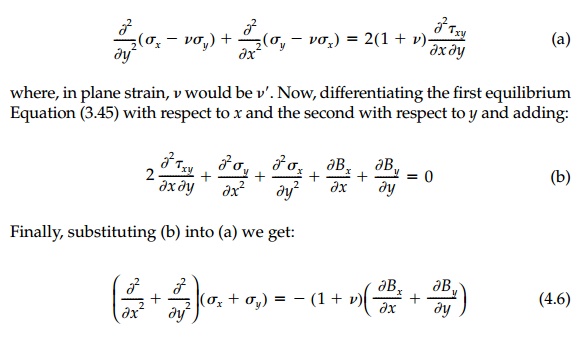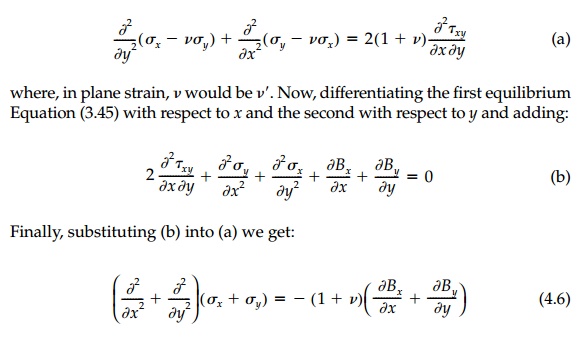Chapter: Civil : Principles of Solid Mechanics : Strategies for Elastic Analysis and Design
Two Dimensional Stress Formulation
Two-Dimensional
Stress Formulation
In 2D it is easy to follow the steps
only outlined in 3D for Equations (4.4) and (4.5) for the direct determination
of stress formulation. Substituting the stress-strain relationships [Equation
(2.4)] into the strain compatibility [Equation (2.7)] gives:

Equation (4.6) for
nonconstant body forces is known as the 'compatibility equation in terms of
stress,' but it actually combines compatibility, equilib-rium, and
stress-strain relations.
This development is remarkable. For a
linear stress-strain material and constant body forces, the 2D field
equations

are independent of material properties!
Thus:
a. In-plane
stresses are identical for any given geometry, loading, and BCs (i.e., stresses
in similar steel, concrete, wood structures are the same).
b. This,
in turn, allows the experimental determination of stress fields using plastic
or other materials.
c. The
in-plane stresses are the same for plane strain or plane stress (which again is
very nice for experimental work since plane strain is difficult to achieve in
the laboratory).
d. Linear
viscoelastic stress fields are the same for constant load (creep) and do not
change with time.
Two-dimensional
solutions are, therefore, very general and powerful.* Conceptually it is
usually easier to think in terms of these stress equations rather than their
displacement counterparts and we will concentrate on this approach.
It is also remarkable that the
mathematics and our previous discussion of the physical importance of the
invariants (independent of coordinate system) seem to be converging. All of a
sudden, the first invariant (the mean stress as the center of Mohr's Circle)
has appeared and in the form of the most com-mon, most studied, best understood
differential equation in the universe:** the Laplace or harmonic equation. The
isotropic component seems to have an equation of its own, uncoupled from the
deviatoric component, which must be described by the equilibrium Equations
(2.45).
Related Topics